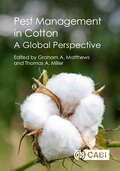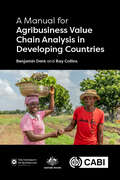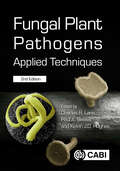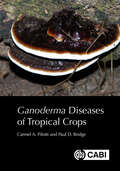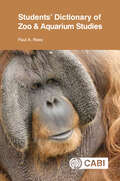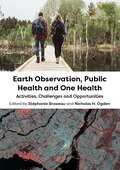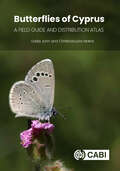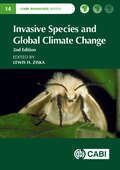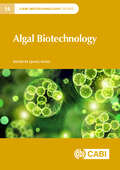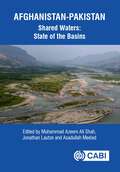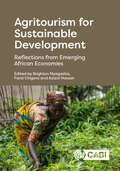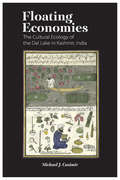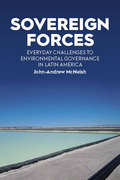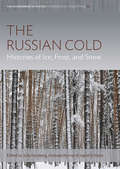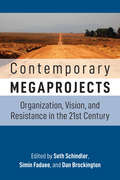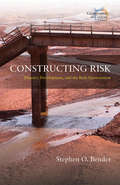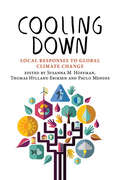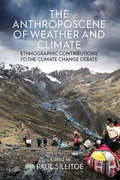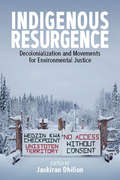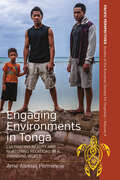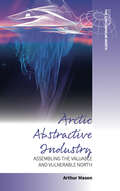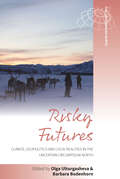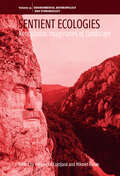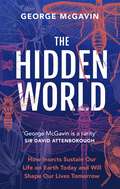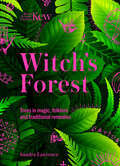- Table View
- List View
Pest Management in Cotton: A Global Perspective
by Zeeshan AhmedThis book presents a global overview of the background to, and the current state of, crop protection and pest management in cotton crops. Cotton is one of the most economically important crops in the world and has been grown for centuries but maintaining high yields of good quality requires sophisticated approaches to pest management. The introduction and use of pesticides over the decades significantly increased cotton yields but lead to many adverse environmental impacts. Over time, new and alternative insecticides were developed but overuse has enabled pests to develop significant resistance. The development of genetically modified cotton varieties with toxins derived from Bacillus thuringiensis enabled much improved control of lepidopteran larvae, including bollworms, but as the toxins had no effect on sucking pests, farmers had no choice but to continue using insecticides. Also, some of the new cotton varieties developed in recent times have not adapted to different climatic conditions and the quality of cotton fibre declined as a result. This book shows the need for more research to select cotton varieties with high quality fibres suitable for different cotton growing areas and to develop integrated pest management strategies to minimise the use of pesticides. It also demonstrates the need for an inter-disciplinary approach bringing together plant breeders, entomologists, plant pathologists, agronomists and agricultural engineers to achieve high yields of high quality cotton. In the future, farmers will need to adopt new technology to determine when and how pesticides are used in conjunction with cultural and biological control strategies. · Emphasises the importance of research on growing cotton in a world experiencing climate change · Demonstrates how crucial crop protection is in achieving high yields of high quality cotton · Shows how new technology will bring major changes in how cotton is grown in the future
A Manual for Agribusiness Value Chain Analysis in Developing Countries
by Dr Benjamin Dent Professor Ray CollinsValue Chain Analysis (VCA) diagnoses the current state of a value chain and makes recommendations to improve its effectiveness and efficiency. Applying VCA in developing countries is very often subject to limited time and funding. This manual shows how VCA principles can be applied under such circumstances. It explains how to undertake an affordable VCA that still generates valid data and so produces recommendations that will have impact. The manual has four parts: Part 1: Our Approach to Value Chain Thinking - sets out the principles and practice of taking a value chain approach. Part 2: Conducting Value Chain Analysis - covers planning a VCA, conducting consumer research, interviewing, analysing, creating recommendations and reporting. Part 3: Case Studies - illustrates successful VCAs with case studies e.g. Ghanaian pineapples and Kenyan indigenous chicken. Part 4: Further Reading and Biographies The practical style and content will make this manual accessible to a wide audience: NGO practitioners; government policymakers and extension officers; private sector managers and consultants; and academics for teaching and researching.
Fungal Plant Pathogens: Applied Techniques
by Kinda Alraiss Rachel Barker Victoria Barton Lucy Carson-Taylor David Cooke Ashleigh Elliot David Galsworthy Steve Hendry Anthony Kermode Paul Kirk Michael Long Aiga Ozolina Ana Pérez-Sierra Belinda Phillipson Matthew J Ryan David Smith Christopher Thornton Jenny Tomlinson Joan WebberThis substantially updated edition now in full colour provides key techniques used when working with fungal and fungal-like plant pathogens. As a practical manual it also deals with disease recognition, detection and identification of fungi, plus methods to characterise and curate fungi and handle them under quarantine and quality assurance systems. Furthermore, this new edition includes significant updates with respect to: - Greater awareness and concern internationally about plant health and biosecurity. - Molecular biology - next generation sequencing and in-field detection. - Improved opportunities for surveillance and detection in diverse substrates. - Changes in taxonomy and reference to current fungal plant pathogens. - New chapters on tree health, and public awareness, outreach and communications. Fungal Plant Pathogens: Applied Techniques, 2nd edition provides a valuable guide to investigating fungal plant diseases and interpreting laboratory findings for postgraduate and advanced undergraduate students, extension plant pathologists, consultants and advisers in agriculture, forestry and horticulture, and the food supply chain.
Ganoderma Diseases of Tropical Crops
by Dr Carmel A Pilotti Paul BridgeThe fungal genus Ganoderma includes around 80 currently recognized species that are widely distributed in temperate, subtropical and tropical regions, and cause disease in a range of economically important perennial crops and tree-like plants. Ganoderma root and lower stem rots have a significant impact on yields from crops including oil palm, coconut, beverage crops, Acacia and rubber. The identification of species responsible for stem and butt rots is often ambiguous as closely related species may only be distinguished by subtle morphological differences. Within species there can be considerable morphological plasticity and this can make morphology-based identification difficult, particularly for species described from a single specimen. Molecular techniques are helping to slowly resolve Ganoderma taxonomy but it will be some time (if ever) before the taxonomy is fully resolved. This book brings together information on Ganoderma species that are reported to be responsible for crop diseases in tropical and sub-tropical agriculture and covers taxonomy, biology, genetics, aetiology, epidemiology and control. This book is an essential resource for researchers in Ganoderma in crop science and tropical agriculture, as well as practitioners and industry.
Students' Dictionary of Zoo and Aquarium Studies
by Dr Paul ReesThis Students' Dictionary of Zoo and Aquarium Studies contains over 5,000 terms (illustrated by 88 figures) used in zoos, aquariums, safari parks, birds of prey centres, petting zoos, animal rescue centres and other facilities that make up the 'zoo industry'. It covers a wide range of topics including animal behaviour, animal husbandry, animal welfare, ecology, law, taxonomy, classification, nutrition, parasitology, physiology, reproduction, experimental design, statistics, veterinary science, disease, visitor studies, water management, wildlife conservation and zoo design and architecture. It should be of great interest to those studying zoo biology, animal management, veterinary science and related subjects along with zookeepers and aquarists in the early stages of their careers. Dr Paul Rees has a long-standing interest in animals and in zoos. He has taught a wide range of subjects including ecology, animal behaviour, zoo biology, and wildlife and zoo law. While lecturing at the University of Salford he created the first undergraduate programme in Wildlife Conservation and Zoo Biology in the United Kingdom and over a period of some 20 years was an external examiner for BSc and MSc programmes in zoo biology and wildlife conservation at the Universities of Edinburgh, Chester, Staffordshire, Wolverhampton, Gloucestershire and Nottingham Trent University. Dr Rees has published research on the large mammal fauna of Ngorongoro Crater, Tanzania, the ecology and behaviour of elephants and cheetahs living in zoos, and the laws concerning wildlife reintroductions and the regulation of zoos.
Earth Observation, Public Health and One Health: Activities, Challenges and Opportunities
by Brazeau Stéphanie Nicholas H. OgdenThis book reviews the contributions of Earth Observation (EO) to public health practices. It examines how EO is being used to understand, track, predict, and manage infectious and chronic diseases, and it provides discussion on the current challenges and the significant development potential of EO to a One Health approach. Its objective is to address a set of questions: How does EO currently assist public health activities? What are the challenges for operational use of EO in public health? What are the opportunities for EO to benefit public health in the near future? This review concentrates on the following priority themes to which EO and geomatics can make important contributions: mosquito-borne and tick-borne diseases; water-borne diseases; air quality and extreme heat effects; and geospatial indicators of vulnerable human populations. EO has also demonstrated potential during the COVID-19 pandemic as an efficient provider of data on rapid environmental and socio-economic changes and impacts. Remotely sensed data are particularly useful for risk modelling and mapping projects to help generate information on occurrence and spatio-temporal trends of disease risk. Similarly, EO can be used to identify risk factors for disease risk or emergence detected in surveillance, and support development of early warning systems. Risk maps enable public health professionals to anticipate and prepare for health threats, and they can support responses to infectious disease epidemics or existing endemic conditions. This book emerged from the collaboration of the Public Health Agency of Canada and the Canadian Space Agency with contributions of international experts. Their findings will be of great value to public health and EO professionals interested in developing and applying geospatial applications in the risk assessment and management of public health issues.
Butterflies of Cyprus: A Field Guide and Distribution Atlas
by Eddie John Christodoulos MakrisThis new book summarises decades of research and collation of distributional data. From the tiny Freyeria trochylus (Grass Jewel), Europe's smallest butterfly, to the magnificent, newly arrived Papilio demoleus (Lime Swallowtail), this comprehensively illustrated reference book and field guide includes all butterfly species known in Cyprus over the past 100 years. Where applicable, reference is made to subspecies of related taxa present in nearby countries of the eastern Mediterranean. The images on the cover represent the island's seven endemics, discussed in depth. Included, too, are detailed distribution maps representing records garnered from almost 300 recorders/sources (particularly members of the Cyprus Butterfly Study Group), over a period of more than 20 years.
Invasive Species and Global Climate Change (CABI Invasives Series)
by Lewis H. ZiskaThis book addresses topics related to the impact of invasive species including biosecurity, demographics, species diversity and food security. It is meant for researchers, upper-level students, and policy makers and provides a factual basis for the underlying science and a discussion of that information with respect to current and future impacts and possible solutions. This book explores the nexus of climate change and biological invasions, resulting impacts (biological and economic) and assesses ways to reduce vulnerability and increase the resiliency and sustainability of managed and unmanaged ecosystems. The book has three parts, focusing on: (1) the dimensions of the problem; background and science; (2) case studies; (3) Management: detection, prevention, control and adaptation. This revised edition examines a wide range of topics and region, the underlying science, examples (case studies) from around the world, and ways and means to recognize, manage and control the consequences. It includes new cases and new threats; for example, a chapter summarizing case studies regarding climate change and invasive species that are also disease carriers (e.g. ticks and Lyme disease). - Covers a wide range of topics and areas - Examines the synergy between invasive species and climate change - Explains options to control and mitigate effects This book is of interest to academics, researchers and students studying climate change and invasive species. Those interested in the environment and ecology, land managers, policy makers, agronomists, federal and state departments of natural resources, climate change activists, public health professionals.
Algal Biotechnology (CABI Biotechnology Series)
by Yahui Bo Gao Chen Lei Chen Zhenfan Chen Zixi Chen Pengfei Cheng Feng Ge Jiameng Guo Sanjay Gupta Xiahui Hao Qingfang He Fan Hu Hanhua Hu Krishna Kumar Jaiswal Hu Jin Vinod Kumar Anping Lei Anna I. Kurbatova Chao Li Yanhua Li Hanzhi Lin Lu-Ning Liu Qiong Liu Yandu Lu Anastasios Melis Yufang Pan Vishal Rajput Roger Ruan Shengzhou Shan Kaitlin Simmons Xiaotong Song Xinyu Song Adamu Yunusa Ugya Mikhail S. Vlaskin Chun Wang Jiangxin Wang Jin Wang Xiaojun Yan Wenxiu Yin Weiwen Zhang Xiangxiang Zhang Xu Zhang Yu-Zhong Zhang Long-Sheng Zhao Quanyu Zhao Chengxu Zhou Yali Zhu Zhu Zhen Tian Jing Cao XupengAlgae are sunlight-driven cell factories, and can efficiently absorb CO2 and convert light energy to chemical energy such as lipid, starch and other carbohydrates and release O2. Algal feedstock is a promising resource for bioproduct production, given its high photosynthetic efficiency for producing biomass compared to conventional crops. Microalgae can be used for flue-gas and wastewater bioremediation. This book highlights recent breakthroughs in the multidisciplinary areas of algal biotechnology and the chapters feature recent developments from cyanobacteria to eukaryotic algae, from theoretical biology to applied biology. It also includes the latest advancements in algal-based synthetic biology, including metabolic engineering, artificial biological system construction and green chemicals production. With contributions by leading authorities in algal biotechnology research, it is a valuable resource for graduate students and researchers in the field, and those involved in the study of photosynthesis and green-cell factories.
Afghanistan-Pakistan Shared Waters: State of the Basins
by Alias Wardak Arif Anwar Fazilda Nabeel Hassaan Furqan Inayatullah Jan Karthikeyan Matheswaran Marie-Charlotte Buisson Muhammad Shahid Iqbal Muhammad Tousif Bhatti Muhammad Zia Hashmi Mujib Ahmad Azizi Paul Pavelic Shakeel Hayat Taimoor AkhtarThere is currently no water cooperation between Afghanistan and Pakistan. Of the nine rivers that flow across the border, none possess a formal agreement or mechanism to manage shared water resources. Further, there is very little information available about the status of environment, hydrology and water resources management for these river basins that could be used as a starting point for dialogues on transboundary water coordination. This State of the Basins book co-develops an overview of the three most important river basins, in collaboration with international experts and water professionals from Afghanistan and Pakistan. It covers water resources, land resources, ecological health, environment, climate change, and the social and economic conditions for sustainable management of these precious resources. It will inform decision making within the two countries, and begin to establish benefits that can accrue from more active collaboration on these shared waters. This book: · Focuses on portions of the Indus shared by Afghanistan and Pakistan. · Features extensive engagement and co-development with Afghan and Pakistani professionals. · Is the first book on the shared waters in the Indus, developed in the context of regional realities associated with post-August 2021 Taliban takeover. The book is aimed at students and researchers in water rights and resources, and government decision makers, private sector investors, donors, intermediary organizations that work directly with farmers, researchers and students. It is a reference book for graduate students and researchers working on these basins, and on transboundary river basin management in Asia and beyond.
Agritourism for Sustainable Development: Reflections from Emerging African Economies
by Admire Mthombeni Bronson Mutanda Collen Sabao Dumisani Rumbidzai Muzira Dzingai Kennedy Nyahunzvi Edward Chinongwa Enard Mutenheri Ernest Mugoni Felix Chari Geoffrey Korir Gilda Eyang Gracious Mutipforo Hellen Amunga Jabulani Garwi Judith Moyo Katsande Chipo Martin Dzapasi Noreen Watyoka Nyasha Tendai Makiwa Lucyna Przezborska-Skobiej Komborerai Wilfred Chikwape Obert Sifile Ranganayi Njodzi Raymond Mapuranga Regis Muchowe Samulo Mutale Sharon Chisango Shingirai Siziba Solomon Marime Tendai Shelton Muwani Tichakunda Valentine Chabata Willard Muntanga Yeukayi Dzapasi Zibanai ZhouThrough the lens of African emerging economies, this text examines empirical studies and the related practices of agritourism. By looking at tourism innovation, entrepreneurship ethics and responsibility of public and private organizational stakeholders, the text promotes an understanding of how radical novel sustainable agritourism might be implemented to help society's living become more sustainable with low usage of material resources, low energy and environmental cost. Informed by the 2030 Agenda for Sustainable Development and Sustainable Development Goals (SDGs) framework, which emphasize the fostering of novel sustainable agritourism, the book includes: methodologies, theory, reviews, primary research findings and practice topics such as start-ups, legal aspects, CSR and digital technologies techniques and tools with global application The book will be of interest to academics and postgraduate students interested in the challenges of sustainable agritourism and African emerging economies.
Floating Economies: The Cultural Ecology of the Dal Lake in Kashmir, India
by Michael J. CasimirIn the Himalayas of the Indian part of Kashmir three communities depend on the ecology of the Dal lake: market gardeners, houseboat owners and fishers. Floating Economies describes for the first time the complex intermeshing economy, social structure and ecology of the area against the background of history and the present volatile socio-political situation. Using a holistic and multidisciplinary approach, the author deals with the socioeconomic strategies of the communities whose livelihoods are embedded here and analyses the ecological condition of the Dal, and the reasons for its progressive degradation.
Sovereign Forces: Everyday Challenges to Environmental Governance in Latin America
by John-Andrew McNeishSovereignty is a significant force regarding the ownership, use, protection and management of natural resources. By placing an emphasis on the complex intertwined relationship between natural resources and diverse claims to resource sovereignty, this book reveals the backstory of contemporary resource contestations in Latin America and their positioning within a more extensive history of extraction in the region. Exploring cases of resource contestation in Bolivia, Colombia and Guatemala, Sovereign Forces highlights the value of these relationships to the practice of environmental governance and peacebuilding in the region.
The Russian Cold: Histories of Ice, Frost, and Snow (Environment in History: International Perspectives #22)
by Julia Herzberg, Andreas Renner, and Ingrid SchierleCold has long been a fixture of Russian identity both within and beyond the borders of Russia and the Soviet Union, even as the ongoing effects of climate change complicate its meaning and cultural salience. The Russian Cold assembles fascinating new contributions from a variety of scholarly traditions, offering new perspectives on how to understand this mainstay of Russian culture and history. In chapters encompassing such diverse topics as polar exploration, the Eastern Front in World War II, and the iconography of hockey, it explores the multiplicity and ambiguity of “cold” in the Russian context and demonstrates the value of environmental-historical research for enriching national and imperial histories.
Contemporary Megaprojects: Organization, Vision, and Resistance in the 21st Century
by Seth Schindler, Simin Fadaee and Dan BrockingtonContemporary megaprojects have evolved from the discreet, modernist projects undertaken in the past by centralized authorities to encompass everything from large-scale construction to space exploration. Contemporary Megaprojects explores how these projects have been impacted by cutting-edge technology, the private sector, and the processes of decentralization and dematerialization. With case studies ranging from mega-plantations in Southeast Asia to ocean mapping to sports events, the contributions in this collected volume demonstrate the increasing ambition and pervasiveness of these projects, as well as their significant impact on both society and the environment.
Constructing Risk: Disaster, Development, and the Built Environment (Catastrophes in Context #4)
by Stephen O. BenderReviewing current policies and practices, the book assesses the financial, economic and physical risk of building in hazardous areas, and looks at how societies are trying to create a more resilient built environment in spite of the dangers. It examines the vulnerability of social infrastructure to natural disasters and looks at policies which imperil infrastructure from natural hazard events and solutions undertaken by sovereign states, international development banks, NGOs and bilateral aid agencies.
Cooling Down: Local Responses to Global Climate Change
by Susanna M. Hoff man, Thomas Hylland Eriksen Paulo MendesClimate change is a slowly advancing crisis sweeping over the planet and affecting different habitats in strikingly diverse ways. While nations have signed treaties and implemented policies, most actual climate change assessments, adaptations, and countermeasures take place at the local level. People are responding by adjusting their practices, livelihoods, and cultures, protesting and migrating. This book portrays the diversity of explanations and remedies as expressed at the community level and its emphasis on the crucial importance of ethnographic detail in demonstrating how people in different parts of the world are scaling down the phenomenon of global warming.
The Anthroposcene of Weather and Climate: Ethnographic Contributions to the Climate Change Debate
by Paul SillitoeWhile it is widely acknowledged that climate change is among the greatest global challenges of our times, it has local implications too. This volume forefronts these local issues, giving anthropology a voice in this great debate, which is otherwise dominated by natural scientists and policy makers. It shows what an ethnographic focus can offer in furthering our understanding of the lived realities of climate debates. Contributors from communities around the world discuss local knowledge of, and responses to, environmental changes that need to feature in scientifically framed policies regarding mitigation and adaptation measures if they are to be effective.
Indigenous Resurgence: Decolonialization and Movements for Environmental Justice
by Jaskiran DhillonFrom the Standing Rock Sioux Tribe’s resistance against the Dakota Access pipeline to the Nepalese Newar community’s protest of the Fast Track Road Project, Indigenous peoples around the world are standing up and speaking out against global capitalism to protect the land, water, and air. By reminding us of the fundamental importance of placing Indigenous politics, histories, and ontologies at the center of our social movements, Indigenous Resurgence positions environmental justice within historical, social, political, and economic contexts, exploring the troubling relationship between colonial and environmental violence and reframing climate change and environmental degradation through an anticolonial lens.
Engaging Environments in Tonga: Cultivating Beauty and Nurturing Relations in a Changing World (Pacific Perspectives: Studies of the European Society for Oceanists #9)
by Arne Aleksej PerminowOn March 11, 2011, a tsunami warning was issued for Tonga in Polynesia. On the low and small island of Kotu, people were unperturbed in the face of impending catastrophe. The book starts out from the puzzle of peoples’ responses and reactions to this warning as well as their attitudes to a gradual rise of sea level and questions why people seemed so unconcerned about this and the accompanying loss of land. The book is an ethnography of the relationship between people and their environment based on fieldwork over three decades.
Arctic Abstractive Industry: Assembling the Valuable and Vulnerable North (Studies in the Circumpolar North #5)
by Arthur MasonThrough diverse engagements with natural resource extraction and ecological vulnerability in the contemporary Arctic, contributors to this volume apprehend Arctic resource regimes through the concept of abstraction. Abstraction refers to the creation of new material substances and cultural values by detaching parts from existing substances and values. The abstractive process differs from the activity of extractive industries by its focus on the conceptual resources that conceal processes of exploitation associated with extraction. The study of abstraction can thus help us attune to the formal operations that make appropriations of value possible while disclosing the politics of extraction and of its representation.
Risky Futures: Climate, Geopolitics and Local Realities in the Uncertain Circumpolar North (Studies in the Circumpolar North #6)
by Olga Ulturgasheva Barbara BodenhornThe volume examines complex intersections of environmental conditions, geopolitical tensions and local innovative reactions characterising ‘the Arctic’ in the early twenty-first century. What happens in the region (such as permafrost thaw or methane release) not only sweeps rapidly through local ecosystems but also has profound global implications. Bringing together a unique combination of authors who are local practitioners, indigenous scholars and international researchers, the book provides nuanced views of the social consequences of climate change and environmental risks across human and non-human realms.
Sentient Ecologies: Xenophobic Imaginaries of Landscape (Environmental Anthropology and Ethnobiology #31)
by Alexandra Coțofană and Hikmet KuranEmploying methodological perspectives from the fields of political geography, environmental studies, anthropology, and their cognate disciplines, this volume explores alternative logics of sentient landscapes as racist, xenophobic, and right-wing. While the field of sentient landscapes has gained critical attention, the literature rarely seems to question the intentionality of sentient landscapes, which are often romanticized as pure, good, and just, and perceived as protectors of those who are powerless, indigenous, and colonized. The book takes a new stance on sentient landscapes with the intention of dispelling the denial of “coevalness” represented by their scholarly romanticization.
The Hidden World: How Insects Sustain Life on Earth Today and Will Shape Our Lives Tomorrow
by George McGavinInsects conquered the Earth long before we did and will remain here long after we're gone.They outnumber us in the billions and are essential to many of the natural processes that keep us alive and that we take for granted.Yet, despite this, very few of us know much about the hidden world of insects.In this fascinating new book, entomologist and broadcaster George McGavin takes a deep dive to reveal the unknown truths about the most successful and enduring animal group the world has ever seen, and to show the unseen effects this vast population has on our planet, if only we care to look.McGavin explores not only the incredible traits that insects have evolved to possess, such as dragonflies that can fly across oceans without resting or beetles that lay their eggs exclusively in corpses, but also the vital lessons we have learnt from them, including how therapy using maggots can save lives and how bees can help grow rich tomato yields.The Hidden World reveals the wonderful complexity of our relationship with insects, how they have changed the course of our history and how, if we continue to learn from them, they could even be the key to our future and survival.
Kew - Witch's Forest: Trees in magic, folklore and traditional remedies
by Royal Botanic Kew Sandra LawrenceThere is more folklore, mythology and magic associated with our trees and forests than with any other living things.Known throughout the world as dark and wild places where witches make mischief and eerie creatures dwell, forests are also places of sanctuary for the ancient magic and the most enchanting species of trees.Kew: Witch's Forest is a beautifully illustrated, captivating journey through the magical woodland and its stories, from birch broomsticks and the sacred olive, to alder doorways and the Tree of Life.
